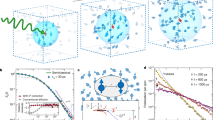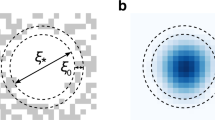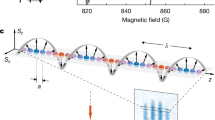Abstract
An outstanding challenge in large-scale quantum platforms is to simultaneously achieve strong interactions, giving rise to the most interesting behaviours, and local addressing, which can probe them. In the context of correlated phases, local addressing allows one to directly probe the nature of the system’s order. At the same time, such addressing allows the study of quantum information spreading and operator growth in out-of-equilibrium scenarios. Here we introduce a technique that enables the measurement of local correlation functions, down to single-site resolution, despite access to only global controls. Our approach leverages the intrinsic disorder present in a solid-state spin ensemble to dephase the non-local components of the correlation function. Utilizing this toolset, we measure both the spin and energy transport in nuclear spin chains. By tuning the interaction Hamiltonian via Floquet engineering, we investigate the cross-over between ballistic and diffusive hydrodynamics. Interestingly, in certain parameter regimes, we observe the coexistence of diffusive spin transport with ballistic energy transport, a hallmark of interacting integrable systems.
This is a preview of subscription content, access via your institution
Access options
Access Nature and 54 other Nature Portfolio journals
Get Nature+, our best-value online-access subscription
$29.99 / 30 days
cancel any time
Subscribe to this journal
Receive 12 print issues and online access
$209.00 per year
only $17.42 per issue
Buy this article
- Purchase on Springer Link
- Instant access to full article PDF
Prices may be subject to local taxes which are calculated during checkout




Similar content being viewed by others
Data availability
Source data are provided with this paper. All other data that support the plots within this paper and other findings of this study are available from the corresponding author upon reasonable request.
References
Halliwell, J. Decoherent histories and the emergent classicality of local densities. Phys. Rev. Lett. 83, 2481–2485 (1999).
Wyatt, R. E. Quantum Dynamics with Trajectories: Introduction to Quantum Hydrodynamics Vol. 28 (Springer Science & Business Media, 2005).
Hartle, J. B. The quasiclassical realms of this quantum universe. Found. Phys. 41, 982–1006 (2011).
Spohn, H. Large Scale Dynamics of Interacting Particles (Springer Science & Business Media, 2012).
Birkhoff, G. in Hydrodynamics (Princeton University Press, 2015).
De Nardis, J., Bernard, D. & Doyon, B. Hydrodynamic diffusion in integrable systems. Phys. Rev. Lett. 121, 160603 (2018).
Andreev, A., Kivelson, S. A. & Spivak, B. Hydrodynamic description of transport in strongly correlated electron systems. Phys. Rev. Lett. 106, 256804 (2011).
Žnidarič, M., Scardicchio, A. & Varma, V. K. Diffusive and subdiffusive spin transport in the ergodic phase of a many-body localizable system. Phys. Rev. Lett. 117, 040601 (2016).
Bertini, B., Collura, M., De Nardis, J. & Fagotti, M. Transport in out-of-equilibrium x x z chains: exact profiles of charges and currents. Phys. Rev. Lett. 117, 207201 (2016).
Leviatan, E., Pollmann, F., Bardarson, J. H., Huse, D. A. & Altman, E. Quantum thermalization dynamics with matrix-product states. Preprint at arXiv:1702.08894 (2017).
Ye, B., Machado, F., White, C. D., Mong, R. S. & Yao, N. Y. Emergent hydrodynamics in nonequilibrium quantum systems. Phys. Rev. Lett. 125, 030601 (2020).
Ljubotina, M., Žnidarič, M. & Prosen, T. Kardar-Parisi-Zhang physics in the quantum Heisenberg magnet. Phys. Rev. Lett. 122, 210602 (2019).
Ye, B., Machado, F., Kemp, J., Hutson, R. B. & Yao, N. Y. Universal Kardar-Parisi-Zhang dynamics in integrable quantum systems. Phys. Rev. Lett. 129, 230602 (2022).
Sommer, A., Ku, M., Roati, G. & Zwierlein, M. W. Universal spin transport in a strongly interacting Fermi gas. Nature 472, 201–204 (2011).
Moll, P. J., Kushwaha, P., Nandi, N., Schmidt, B. & Mackenzie, A. P. Evidence for hydrodynamic electron flow in PdCoO2. Science 351, 1061–1064 (2016).
Cepellotti, A. et al. Phonon hydrodynamics in two-dimensional materials. Nat. Commun. 6, 6400 (2015).
Crossno, J. et al. Observation of the dirac fluid and the breakdown of the wiedemann-franz law in graphene. Science 351, 1058–1061 (2016).
Agarwal, K., Gopalakrishnan, S., Knap, M., Müller, M. & Demler, E. Anomalous diffusion and griffiths effects near the many-body localization transition. Phys. Rev. Lett. 114, 160401 (2015).
Castro-Alvaredo, O. A., Doyon, B. & Yoshimura, T. Emergent hydrodynamics in integrable quantum systems out of equilibrium. Phys. Rev. X 6, 041065 (2016).
Bertini, B. Finite-temperature transport in one-dimensional quantum lattice models. Rev. Mod. Phys. 93, 025003 (2021).
Ilievski, E. & De Nardis, J. Microscopic origin of ideal conductivity in integrable quantum models. Phys. Rev. Lett. 119, 020602 (2017).
Gopalakrishnan, S. & Vasseur, R. Kinetic theory of spin diffusion and superdiffusion in x x z spin chains. Phys. Rev. Lett. 122, 127202 (2019).
De Nardis, J., Bernard, D. & Doyon, B. Diffusion in generalized hydrodynamics and quasiparticle scattering. SciPost Phys 6, 049 (2019).
Ilievski, E., De Nardis, J., Gopalakrishnan, S., Vasseur, R. & Ware, B. Superuniversality of superdiffusion. Phys. Rev. X 11, 031023 (2021).
De Nardis, J., Gopalakrishnan, S., Vasseur, R. & Ware, B. Stability of superdiffusion in nearly integrable spin chains. Phys. Rev. Lett. 127, 057201 (2021).
Friedman, A. J., Gopalakrishnan, S. & Vasseur, R. Diffusive hydrodynamics from integrability breaking. Phys. Rev. B 101, 180302 (2020).
Schemmer, M., Bouchoule, I., Doyon, B. & Dubail, J. Generalized hydrodynamics on an atom chip. Phys. Rev. Lett. 122, 090601 (2019).
Zu, C. et al. Emergent hydrodynamics in a strongly interacting dipolar spin ensemble. Nature 597, 45–50 (2021).
Malvania, N. et al. Generalized hydrodynamics in strongly interacting 1d bose gases. Science 373, 1129–1133 (2021).
Wei, D. et al. Quantum gas microscopy of Kardar-Parisi-Zhang superdiffusion. Science 376, 716–720 (2022).
Joshi, M. K. et al. Observing emergent hydrodynamics in a long-range quantum magnet. Science 376, 720–724 (2022).
Martin, L. S. et al. Controlling local thermalization dynamics in a Floquet-engineered dipolar ensemble. Preprint at arXiv:2209.09297 (2022).
Altman, E. et al. Quantum simulators: architectures and opportunities. PRX Quantum 2, 017003 (2021).
Bakr, W. S., Gillen, J. I., Peng, A., Folling, S. & Greiner, M. A quantum gas microscope for detecting single atoms in a Hubbard-regime optical lattice. Nature 462, 74–77 (2009).
Zhang, W. & Cory, D. First direct measurement of the spin diffusion rate in a homogenous solid. Phys. Rev. Lett. 80, 1324 (1998).
Rittweger, E., Han, K. Y., Irvine, S. E., Eggeling, C. & Hell, S. W. STED microscopy reveals crystal colour centres with nanometric resolution. Nat. Photonics 3, 144–147 (2009).
Maurer, P. et al. Far-field optical imaging and manipulation of individual spins with nanoscale resolution. Nat. Phys. 6, 912–918 (2010).
Chen, E. H., Gaathon, O., Trusheim, M. E. & Englund, D. Wide-field multispectral super-resolution imaging using spin-dependent fluorescence in nanodiamonds. Nano Lett. 13, 2073–2077 (2013).
Pfender, M., Aslam, N., Waldherr, G., Neumann, P. & Wrachtrup, J. Single-spin stochastic optical reconstruction microscopy. Proc. Natl Acad. Sci. USA 111, 14669–14674 (2014).
Arai, K. et al. Fourier magnetic imaging with nanoscale resolution and compressed sensing speed-up using electronic spins in diamond. Nat. Nanotechnol. 10, 859–864 (2015).
Hunt, G. A. Some theorems concerning brownian motion. Trans. Am. Math. Soc. 81, 294–319 (1956).
Waugh, J. S., Huber, L. M. & Haeberlen, U. Approach to high-resolution nmr in solids. Phys. Rev. Lett. 20, 180–182 (1968).
Jeener, J. & Broekaert, P. Nuclear magnetic resonance in solids: thermodynamic effects of a pair of rf pulses. Phys. Rev. 157, 232–240 (1967).
Haeberlen, U. & Waugh, J. S. Coherent averaging effects in magnetic resonance. Phys. Rev. 175, 453–467 (1968).
Peng, P. et al. Deep reinforcement learning for quantum hamiltonian engineering. Phys. Rev. Appl. 18, 024033 (2022).
Grabowski, M. & Mathieu, P. Structure of the conservation laws in quantum integrable spin chains with short range interactions. Ann. Phys. 243, 299–371 (1995).
Zotos, X., Naef, F. & Prelovsek, P. Transport and conservation laws. Phys. Rev. B 55, 11029–11032 (1997).
Klümper, A. & Johnston, D. Thermodynamics of the spin-1/2 antiferromagnetic uniform Heisenberg chain. Phys. Rev. Lett. 84, 4701–4704 (2000).
Sakai, K. & Klümper, A. Non-dissipative thermal transport in the massive regimes of the xxz chain. J. Phys. A: Math. Gen. 36, 11617–11629 (2003).
Prosen, T. & Žnidarič, M. Matrix product simulations of non-equilibrium steady states of quantum spin chains. J. Stat. Mech.: Theory Exp. 2009, P02035 (2009).
Steinigeweg, R. & Gemmer, J. Density dynamics in translationally invariant spin-1 2 chains at high temperatures: a current-autocorrelation approach to finite time and length scales. Phys. Rev. B 80, 184402 (2009).
Žnidarič, M. Spin transport in a one-dimensional anisotropic Heisenberg model. Phys. Rev. Lett. 106, 220601 (2011).
Karrasch, C., Moore, J. & Heidrich-Meisner, F. Real-time and real-space spin and energy dynamics in one-dimensional spin-1 2 systems induced by local quantum quenches at finite temperatures. Phys. Rev. B 89, 075139 (2014).
Lucioni, E. et al. Observation of subdiffusion in a disordered interacting system. Phys. Rev. Lett. 106, 230403 (2011).
Vosk, R., Huse, D. A. & Altman, E. Theory of the many-body localization transition in one-dimensional systems. Phys. Rev. X 5, 031032 (2015).
Potter, A. C., Vasseur, R. & Parameswaran, S. Universal properties of many-body delocalization transitions. Phys. Rev. X 5, 031033 (2015).
Sahay, R., Machado, F., Ye, B., Laumann, C. R. & Yao, N. Y. Emergent ergodicity at the transition between many-body localized phases. Phys. Rev. Lett. 126, 100604 (2021).
Zaburdaev, V., Denisov, S. & Klafter, J. Lévy walks. Rev. Mod. Phys. 87, 483–530 (2015).
Nahum, A., Vijay, S. & Haah, J. Operator spreading in random unitary circuits. Phys. Rev. X 8, 021014 (2018).
Von Keyserlingk, C., Rakovszky, T., Pollmann, F. & Sondhi, S. L. Operator hydrodynamics, OTOCs, and entanglement growth in systems without conservation laws. Phys. Rev. X 8, 021013 (2018).
Rakovszky, T. & Pollmann, F. & Von Keyserlingk, C. Diffusive hydrodynamics of out-of-time-ordered correlators with charge conservation. Phys. Rev. X 8, 031058 (2018).
Khemani, V., Vishwanath, A. & Huse, D. A. Operator spreading and the emergence of dissipative hydrodynamics under unitary evolution with conservation laws. Phys. Rev. X 8, 031057 (2018).
Xu, S. & Swingle, B. Accessing scrambling using matrix product operators. Nat. Phys. 16, 199–204 (2020).
Xu, S. & Swingle, B. Locality, quantum fluctuations, and scrambling. Phys. Rev. X 9, 031048 (2019).
Sahu, S., Xu, S. & Swingle, B. Scrambling dynamics across a thermalization-localization quantum phase transition. Phys. Rev. Lett. 123, 165902 (2019).
Schuster, T. et al. Many-body quantum teleportation via operator spreading in the traversable wormhole protocol. Phys. Rev. X 12, 031013 (2022).
Li, J. et al. Measuring out-of-time-order correlators on a nuclear magnetic resonance quantum simulator. Phys. Rev. X 7, 031011 (2017).
Landsman, K. A. et al. Verified quantum information scrambling. Nature 567, 61–65 (2019).
Blok, M. S. et al. Quantum information scrambling on a superconducting qutrit processor. Phys. Rev. X 11, 021010 (2021).
Wei, K. X. et al. Emergent prethermalization signatures in out-of-time ordered correlations. Phys. Rev. Lett. 123, 090605 (2019).
Cappellaro, P., Ramanathan, C. & Cory, D. G. Simulations of information transport in spin chains. Phys. Rev. Lett. 99, 250506 (2007).
Cappellaro, P., Viola, L. & Ramanathan, C. Coherent-state transfer via highly mixed quantum spin chains. Phys. Rev. A 83, 032304 (2011).
Ramanathan, C., Cappellaro, P., Viola, L. & Cory, D. G. Experimental characterization of coherent magnetization transport in a one-dimensional spin system. New J. Phys. 13, 103015 (2011).
Rufeil-Fiori, E., Sánchez, C. M., Oliva, F. Y., Pastawski, H. M. & Levstein, P. R. Effective one-body dynamics in multiple-quantum nmr experiments. Phys. Rev. A 79, 032324 (2009).
Zhang, W. et al. NMR multiple quantum coherences in quasi-one-dimensional spin systems: comparison with ideal spin-chain dynamics. Phys. Rev. A 80, 052323 (2009).
Comodi, P., Liu, Y., Zanazzi, P. & Montagnoli, M. Structural and vibrational behaviour of fluorapatite with pressure. Part I: in situ single-crystal x-ray diffraction investigation. Phys. Chem. Miner. 28, 219–224 (2001).
Acknowledgements
We thank C. Ramanathan, H. Zhou, M. Leigh, N. Leitao, F. Machado, J. Kemp, J. Moore and M. Lukin for helpful conversations. This work was supported in part by the National Science Foundation under grant No. PHY1915218. P.P. thanks MathWorks for their support in the form of a Graduate Student Fellowship. The opinions and views expressed in this publication are from the authors and not necessarily from MathWorks. B.Y. acknowledges support from the Army Research Office through the MURI program (W911NF-20-1-0136). N.Y.Y. acknowledges support from the NSF through the QLCI program (OMA-2016245) and the David and Lucile Packard foundation.
Author information
Authors and Affiliations
Contributions
P.P. designed and performed the experiment with assistance from P.C. B.Y. and N.Y.Y. performed the numerical and analytical calculations. P.C. supervised the project. All authors worked on the interpretation of the data and contributed to writing the manuscript.
Corresponding authors
Ethics declarations
Competing interests
The authors declare no competing interests.
Peer review
Peer review information
Nature Physics thanks Jianming Cai and the other, anonymous, reviewer(s) for their contribution to the peer review of this work.
Additional information
Publisher’s note Springer Nature remains neutral with regard to jurisdictional claims in published maps and institutional affiliations.
Extended data
Extended Data Fig. 1 Ab initio calculation of disordered field and decoherence profile.
Disordered on-site field generated by 31P. a. Numerical calculation of distribution of the on-site field strength. The four-Gaussian fit gives a standard deviation of 2.217(2) krad/s for each Gaussian peak. The single-Gaussian fit gives a standard deviation of 6.05(6) krad/s. b. Left axis: Decoherence profile generated by the calculated distribution of on-site field and the single-peak Gaussian approximation. Right axis: Statistical correlation between the random amplitudes of local observables on two closest 19F. As the coherence approaches zero, the statistical correlation also vanishes.
Extended Data Fig. 2 Raw data for transport with disorder.
Spin (a) and energy (b) autocorrelation for various disorder field strength h. Data are presented as mean values +/- SD from readout noise (for additional details see the Supplementary Information).
Supplementary information
Supplementary Information
Supplementary Figs 1–4, Discussion and Table 1.
Source data
Source Data Fig. 2
Statistical source data.
Source Data Fig. 3
Statistical source data.
Source Data Fig. 4
Statistical source data.
Source Data Extended Data Fig. 1
Statistical source data.
Source Data Extended Data Fig. 2
Statistical source data.
Rights and permissions
Springer Nature or its licensor (e.g. a society or other partner) holds exclusive rights to this article under a publishing agreement with the author(s) or other rightsholder(s); author self-archiving of the accepted manuscript version of this article is solely governed by the terms of such publishing agreement and applicable law.
About this article
Cite this article
Peng, P., Ye, B., Yao, N.Y. et al. Exploiting disorder to probe spin and energy hydrodynamics. Nat. Phys. 19, 1027–1032 (2023). https://doi.org/10.1038/s41567-023-02024-4
Received:
Accepted:
Published:
Issue Date:
DOI: https://doi.org/10.1038/s41567-023-02024-4
This article is cited by
-
Universal hypothesis of autocorrelation function from Krylov complexity
Quantum Frontiers (2024)
-
A local probe for many-body physics
Nature Physics (2023)



